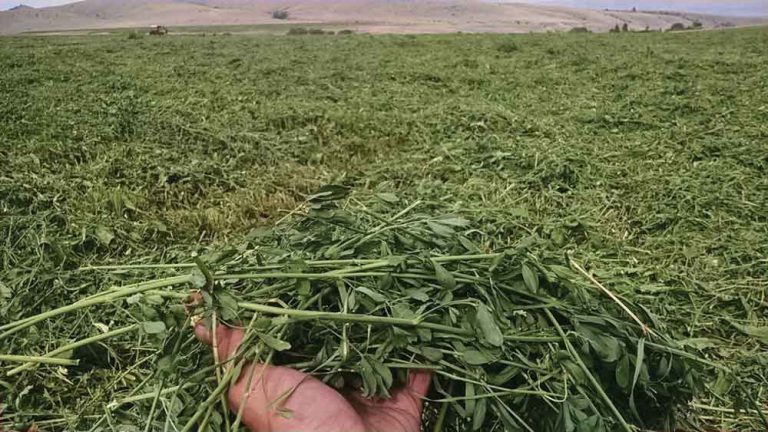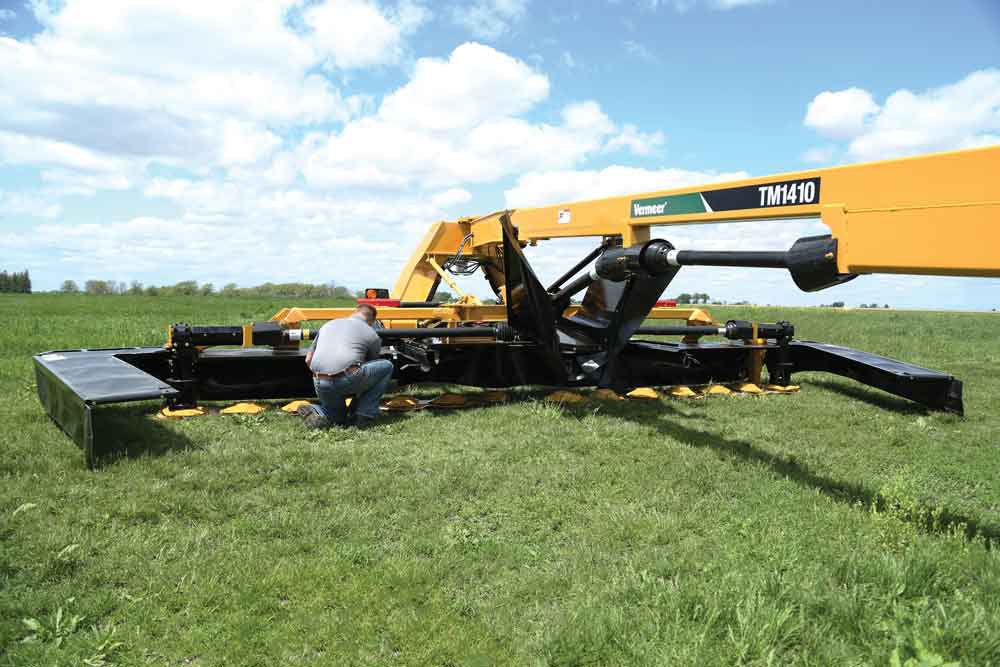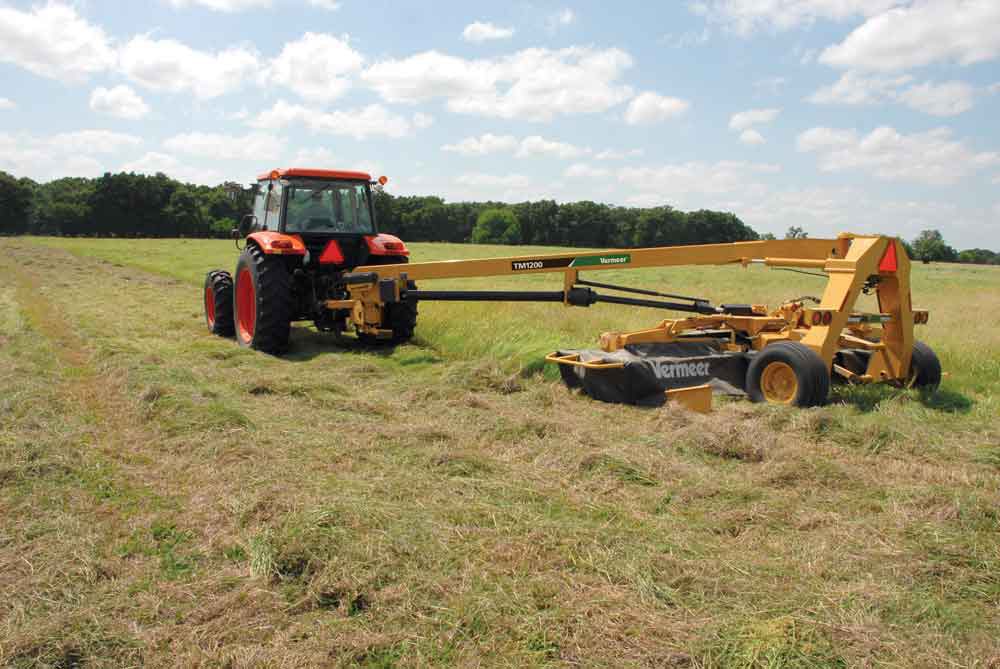
Boost Hay Quality and Reduce Cost
February 2017
Everybody has their own theories on forage harvesting practices but one method has certainly attracted a lot of interest among researchers and producers lately.
Since 2003, “wide swath,” a term typically used by most in the know, has been thoroughly studied, researched trailed and recommended by forage experts as the most effective way for producers to speed up and boost the nutritional value of their forage. Early adopters have been recording some remarkable differences in cost efficiencies and forage quality. And the cows are lovin’ it.
Technically speaking, a wide swath encourages faster photosynthesis and translocation from photosynthesis. This creates more airflow over the material.1 In fact, the first 30 percent of dry down is accomplished mostly through photosynthesis and translocation. When forage is mowed into a wide swath, it speeds up the respiration process. By the time downed hay reaches 60 percent moisture, the wide swath has fulfilled its intended purpose because respiration has mostly stopped.
This relatively new management practice took hold shortly after two extensive studies were conducted by Cornell University and the University of Wisconsin.2, 3 Both presented some impressive findings. Since then, the wide swath trend has been growing rapidly and the benefits, especially in haylage production, have been many. Shorter wilting periods. Lower respiration losses. Higher sugar/starch content (especially for first-cut forages). Better quality forage. More digestible energy. Improved fermentation. Less chance of rain damage.
And for dairy farmers? Incremental improvements in milk production with increases reported at about 300 lb in milk production per ton of haylage fed.

“We’re just now starting to do a much better job of maximizing quality and TDN in our harvested forages because we’re paying much more attention to the biology and physics of properly drying forage,” said Dan Undersander, University of Wisconsin Forage Agronomist.
Researchers have found that rapidly reducing moisture level percentages (by about 15 points) in the plant helps reduce the loss of starches and sugars during the dry down process. Most of the early moisture losses take place in the leaf. Using a wide swath is the fastest and most effective way to accelerate the respiration process because it maximizes exposure of the leaves to the natural drying effects of sunshine and airflow. This applies to both high-moisture and dry hay harvesting practices.
“Customers have been reporting these kinds of results for years, particularly in silage with increases in quality, palatability, digestibility and higher feed value,” said Josh Vrieze, Product Manager at Vermeer. “Virtually every study we see is documenting the same kind of results, and it just makes sense. With wide swaths, you’re using the energy of the sun instead of fuel to get the crop ready for harvest. Plus, the initial investment is lower, because a wide swath trailed mower is typically about two-thirds the cost of a mower conditioner. That means you can use a bigger mower and cut a wider swath without having to use a conditioner. In some cases, customers reduce their fuel costs as much as 50 percent.”
“In most areas of the country, if you’re harvesting dry hay, conditioning is crucial because of the need to reach 15 to 20 percent moisture levels,” Vrieze added. “Strategies for wilting silage are very different compared to dry hay production, because conditioning the stems is extremely important. However, the practice of forming wide swaths (at a higher percentage relative to the cutting width) has advantages whether you’re harvesting high-moisture or dry hay. Swath width percentages in most mowers can range anywhere from 28 to 87 percent*. Preferably, you want it to be in that 70 to 75 plus percentile. The wider, the better.”
Concerned about driving over a swath? According to additional studies conducted by Undersander, ash content in wide swath alfalfa was actually less than that in narrow windrows, because wide swaths tend to remain on top of cut stubble. 3 On the other hand, narrow windrows tend to sag to the ground, which increases the chance of soil contamination later when the windrow is picked up. One way to minimize damage is to drive one wheel on the area between swaths and one near the middle of the swath where cut forage is thinner.
Want to retain the added benefits of conditioning and still be able to lay your crop wide? Tedders are a great solution, because they allow you to spread out the hay and use the whole field to capture sunlight for faster drying.
“Tedders are probably one of the most underused pieces of haying equipment,” Vrieze said. “They can be used in many ways, especially if drying conditions aren’t good or if the hay gets rained on. Of course, no tedder makes it as smooth as wide swathing, but it’s another great way to accelerate and extend the natural drying forces, especially when you’re harvesting dry bales.”

Vermeer dealer, Burton Ouzts (Athens Tractor & Implement in Athens, Texas), said farmers in his area place a huge premium on high production haying, so the new Vermeer TM1410 trailed mower makes sense, because it can cut up to 20.8 ft in width and leave nearly a 19 ft wide swath (that’s roughly 85 percent of the cutting width).
“A lot of guys think the (TM1410) unit is designed primarily for large fields, but it’s also easy to use in smaller fields, because it easily folds down to 9.1 ft for transport,” Ouzts said.
“When you run the numbers, you’ll find the bigger trailed mowers match up well against the productivity of two 80 hp tractors pulling 10 ft mowers,” Ouzts added. “They may not cut costs in half, because you may need to power them with a slightly larger tractor; but you’re operating and maintaining only one implement, fueling just one tractor, and you only need one operator.”
With the new 10-series trailed mowers from Vermeer, producers can now cut up to 20.8 ft while leaving the crop in nearly a 19 ft wide swath. This is ideal for harvesting most forages in Texas. Operators are also able to cut more hay in less time with an 85-100 hp tractor. In addition, several built-in conveniences help take the stress out of operating, transporting and maintaining these larger trailed mowers — new, improved Q3® Cutter Bar and 2-point Quick Hitch hook up; nitrogen-charged accumulator suspension system; patented Quick-Clip® Blade Retention System (which cut the process of blade replacement to seconds); a 3-year cutter bar warranty on parts and labor; plus narrow 9.1 ft transport width for fast, easy transport through the gate and on the highway.
How Does It Work In A Grass/Alfalfa Mix?
A recent study (2016) near Winston, Montana conducted by Nate Cox (Cox Ranch Equipment in Winston, Montana) compared dry down rates – tracking the cutting-to-harvesting stage using four different harvesting practices – for a field of hay/alfalfa harvested at mid- to high-teen moisture levels. Tests were not conducted on hay quality.

